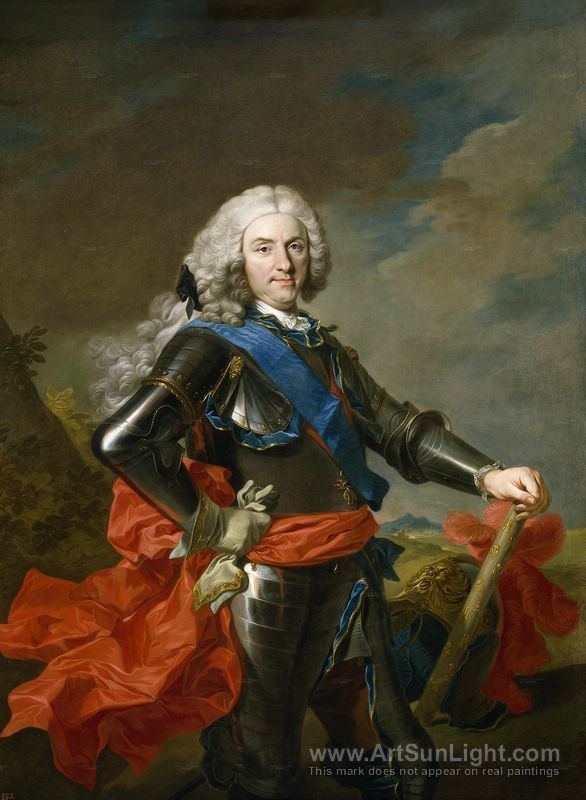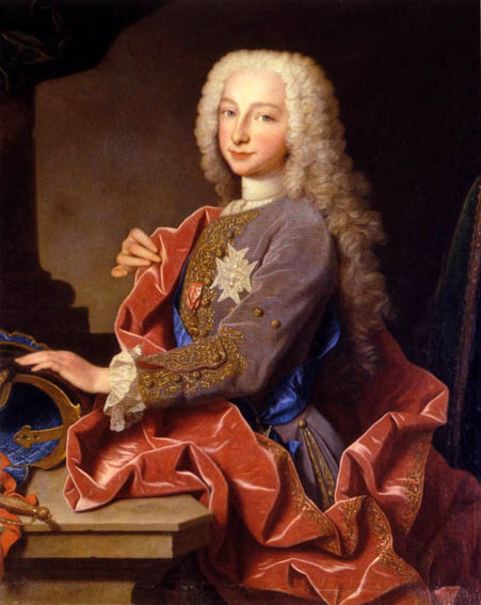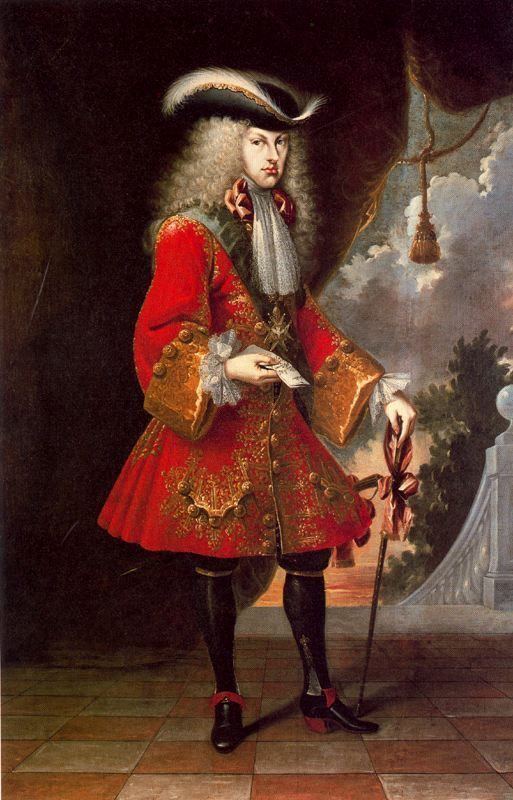Predecessor Charles II Name Philip of | Role King of Spain | |
 | ||
1st reign 6 November 1700 –15 January 1724 2nd reign 6 September 1724 –9 July 1746 Children Charles III of Spain, Ferdinand VI of Spain Parents Duchess Maria Anna Victoria of Bavaria, Louis, Grand Dauphin Similar People Charles III of Spain, Charles II of Spain, Ferdinand VI of Spain, Philip IV of Spain, Charles IV of Spain | ||
Philip v of spain
Philip V (Spanish: Felipe V, French: Philippe, Italian: Filippo; 19 December 1683 – 9 July 1746) was King of Spain from 1 November 1700 to 15 January 1724, when he abdicated in favour of his son Louis, and from 6 September 1724, when he assumed the throne again upon his son's death, to his own death 9 July 1746.
Contents
- Philip v of spain
- Early years
- Claims to the Spanish throne
- First marriage
- War of the Spanish Succession
- Second marriage
- Abdication
- Later reign
- Death
- Issue
- Legacy
- References

Before his reign, Philip occupied an exalted place in the royal family of France as a grandson of King Louis XIV. His father, Louis, the Grand Dauphin, had the strongest genealogical claim to the throne of Spain when it became vacant in 1700. However, since the Grand Dauphin and Philip's older brother, Louis, Duke of Burgundy, could not be displaced from their place in the succession to the French throne, King Charles II of Spain named Philip as his heir in his will. It was well known that the union of France and Spain under one monarch would upset the balance of power in Europe, such that other European powers would take steps to prevent it. Indeed, Philip's accession in Spain provoked the 14-year War of the Spanish Succession, which continued until the Treaty of Utrecht forbade any future possibility of unifying the French and Spanish thrones.

Philip was the first member of the House of Bourbon to rule as king of Spain. The sum of his two reigns, 45 years and 21 days, is the longest in modern Spanish history.

Philip v of spain
Early years

Philip was born at the Palace of Versailles in France the second son of Louis, Grand Dauphin, the heir apparent to the throne of France, and his wife Maria Anna Victoria of Bavaria, Dauphine Victoire. He was a younger brother of Louis, Duke of Burgundy, the father of Louis XV of France. At birth, Philip was created Duke of Anjou, a traditional title for younger sons in the French royal family. He would be known by this name until he became the king of Spain. Since Philip's older brother, the Duke of Burgundy, was second in line to the French throne after his father, there was little expectation that either he or his younger brother Charles, Duke of Berry, would ever rule over France.

Philip was tutored with his brothers by Francois Fenelon, Archbishop of Cambrai. The three were also educated by Paul de Beauvilliers.
Claims to the Spanish throne
In 1700 the King Charles II of Spain died childless. His will named the 16-year-old Philip, grandson of Charles' half-sister Maria Theresa of Spain, the first wife of Louis XIV, as his successor. Upon any possible refusal, the crown of Spain would be offered next to Philip's younger brother, the Duke of Berry, then to the Archduke Charles of Austria, later Holy Roman Emperor Charles VI. Philip had the better genealogical claim to the Spanish throne, because his Spanish grandmother and great-grandmother were older than the ancestors of the Archduke Charles of Austria. However, the Austrian branch claimed that Philip's grandmother had renounced the Spanish throne for herself and her descendants as part of her marriage contract. This was countered by the French branch's claim that it was on the basis of a dowry that had never been paid.
After a long Royal Council meeting in France at which the Dauphin spoke up in favour of his son's rights, it was agreed that Philip would ascend the throne, but would forever renounce his claim to the throne of France for himself and his descendants.
After the Royal Council decided to accept the provisions of the will of Charles II naming Philip king of Spain, the Spanish ambassador was called in and introduced to his new king. The ambassador, along with his son, knelt before Philip and made a long speech in Spanish which Philip did not understand, although Louis XIV (the son and husband of Spanish princesses) did. Philip only later learned to speak Spanish.
First marriage
On 2 November 1701 Philip married the 13-year-old Maria Luisa of Savoy, as chosen by his grandfather. She was the daughter of Victor Amadeus II, Duke of Savoy, and Philip's second cousin Anne Marie d'Orleans, also the parents of the Duchess of Burgundy, Philip's sister-in-law. There was a proxy ceremony at Turin, the capital of the Duchy of Savoy, and another one at Versailles on 11 September.
As queen of Spain, Maria Luisa proved very popular with her subjects. She served as regent for her husband on several occasions. Her most successful term was when Philip was away touring his Italian domains for nine months in 1702. In 1714, she died at the age of 26 from tuberculosis, a devastating emotional blow to her husband.
War of the Spanish Succession
The actions of Louis XIV heightened the fears of the English, the Dutch and the Austrians, among others. In February 1701, Louis XIV caused the Parlement of Paris (a court) to register a decree that if Philip's elder brother, the Petit Dauphin Louis, died without an heir, then Philip would surrender the throne of Spain for the succession to the throne of France, ensuring dynastic continuity in Europe's greatest land power.
However, a second act of the French king "justified a hostile interpretation": pursuant to a treaty with Spain, Louis occupied several towns in the Spanish Netherlands (modern Belgium and Nord-Pas-de-Calais). This was the spark that ignited the powder keg created by the unresolved issues of the War of the League of Augsburg (1689–97) and the acceptance of the Spanish inheritance by Louis XIV for his grandson.
Almost immediately the War of the Spanish Succession began. Concern among other European powers that Spain and France united under a single Bourbon monarch would upset the balance of power pitted powerful France and weak Spain against the Grand Alliance of England, the Netherlands and Austria.
Inside Spain, the Crown of Castile supported Philip of France. On the other hand, the majority of the nobility of the Crown of Aragon supported Charles of Austria, son of Holy Roman Emperor Leopold I and claimant to the Spanish throne by right of his grandmother Maria Anna of Spain. Charles was even hailed as King of Aragon under the name Charles III.
The war was centred in Spain and west-central Europe (especially the Low Countries), with other important fighting in Germany and Italy. Prince Eugene of Savoy and the Duke of Marlborough distinguished themselves as military commanders in the Low Countries. In colonial North America, the conflict became known to the English colonists who fought against French and Spanish forces as Queen Anne's War. Over the course of the fighting, some 400,000 people were killed.
It was with this war as a backdrop that, beginning in 1707, Philip issued the Nueva Planta decrees, which centralized Spanish rule under the Castilian political and administrative model and in the process abolished the charters of all independently administered kingdoms within Spain—most notably the Crown of Aragon, which was supporting Charles VI in the conflict—except for the Kingdom of Navarre and the rest of the Basque region, who had supported Philip in the war for the Spanish throne, and retained their semi-autonomous self-government. The policy of centralization had as model the French State under Louis XIV and was strongly supported by politicians such as Joseph de Solis and the Sardinian-born political philosopher Vicente Bacallar.
At one point in 1712 Philip was offered the choice of renouncing the throne of Spain so that he could be made heir of France, but he refused.
Philip decided to relinquish his right of succession to France under one condition: the introduction of semi-Salic law in Spain. Under this law, the succession to the Spanish crown was limited to his entire male line before it could pass to any female, a condition of his renunciation made clear to the allies during the preliminaries of the Treaties of Utrecht. It was not until this was successfully accomplished (10 May 1713) that Spain and Great Britain made their own peace terms at the second Treaty of Utrecht (annexing the new law to the Treaty). By the terms of the Treaty of Utrecht that concluded the war, Spain was forced to cede Minorca and Gibraltar to Great Britain; the Spanish Netherlands, Naples, Milan, and Sardinia to the Austrian Habsburgs; and Sicily and parts of Milan to Savoy.
These losses greatly diminished the Spanish Empire in Europe, which had already been in decline. Throughout his reign, Philip sought to reverse the decline of Spanish power. Trying to overturn the terms of the Treaty of Utrecht, he attempted to re-establish Spanish claims in Italy, triggering the War of the Quadruple Alliance (1718-1720) in which Spain fought a coalition of four major powers. Phillip V was forced to sue for peace.
Second marriage
Shortly after the death of Queen Maria Luisa in 1714, the King decided to marry again. His second wife was Elisabeth of Parma, daughter of Odoardo Farnese, Hereditary Prince of Parma, and Dorothea Sophie of the Palatinate. At the age of twenty-one, on 24 December 1714, she was married by proxy in Parma. The marriage was arranged by Cardinal Alberoni, with the concurrence of the Princesse des Ursins, the Camarera mayor de Palacio ("chief of the household") of the king of Spain.
Abdication
On 14 January 1724, Philip abdicated the throne to his eldest son, the seventeen-year-old Louis, for reasons still subject to debate. One theory suggests that Philip V, who exhibited many elements of mental instability during his reign, did not wish to reign due to his increasing mental decline. A second theory puts the abdication in context of the Bourbon dynasty. The French royal family recently had lost many legitimate agnates to diseases. Indeed, Philip V's abdication occurred just over a month after the death of the Duke of Orleans, who had been regent for Louis XV of France. The lack of an heir made another continental war of succession a possibility. Philip V was a legitimate descendant of Louis XIV, but matters were complicated by the Treaty of Utrecht, which forbade a union of the French and Spanish crowns. The theory supposes that Philip V hoped that by abdicating the Spanish crown he could circumvent the Treaty and succeed to the French throne.
In any case, Louis died on 31 August 1724 in Madrid of smallpox, having reigned only seven months and leaving no issue. Philip was forced to return to the Spanish throne as his younger son, the later Ferdinand VI, was not yet of age.
Later reign
Philip helped his Bourbon relatives to make territorial gains in the War of the Polish Succession and the War of the Austrian Succession by reconquering Naples and Sicily from Austria and Oran from the Ottomans. Finally, at the end of his reign Spanish forces also successfully defended their American territories from a large British invasion during the War of Jenkins' Ear.
During Philip's reign, Spain began to recover from the stagnation it had suffered during the twilight of the Spanish Habsburg dynasty. Although the population of Spain grew, the financial and taxation systems were archaic and the treasury ran deficits. The king employed thousands of highly paid retainers at his palaces—not to rule the country but to look after the royal family. The army and bureaucracy went months without pay and only the shipments of silver from the New World kept the system going. Spain suspended payments on its debt in 1739—effectively declaring bankruptcy.
Death
Philip was afflicted by fits of manic depression and increasingly fell victim to a deep melancholia. His second wife, Elizabeth Farnese, completely dominated her passive husband. She bore him further sons, including another successor, Charles III of Spain. Beginning in August 1737 his affliction was eased by the castrato singer Farinelli, who, became the "Musico de Camara of Their Majesties." Farinelli would sing eight or nine arias for the king and queen every night, usually with a trio of musicians.
Philip died on 9 July 1746 in El Escorial, in Madrid, but was buried in his favorite Royal Palace of La Granja de San Ildefonso, near Segovia. Ferdinand VI of Spain, his son by his first queen Maria Luisa of Savoy, succeeded him.
Issue
Philip married his double-second cousin Maria Luisa of Savoy (17 September 1688 – 14 February 1714) on 3 November 1701 and they had 4 sons:
- Louis I of Spain (25 August 1707 – 31 August 1724). Wife - Louise Elisabeth d'Orleans.
- Philip (2 July 1709 – 18 July 1709).
- Philip (7 June 1712 – 29 December 1719).
- Ferdinand VI of Spain (23 September 1713 – 10 August 1759). Wife - Barbara of Portugal.
He married Elisabeth Farnese (25 October 1692 – 11 July 1766) on 24 December 1714, they had 6 children:
- Charles III of Spain (20 January 1716 – 14 December 1788). Wife - Maria Amalia of Saxony.
- Mariana Victoria (31 March 1718 – 15 January 1781), Queen of Portugal as wife of King Joseph.
- Philip (15 March 1720 – 18 July 1765), Duke of Parma and founder of the line of House of Bourbon-Parma. Wife - Louise Elisabeth of France.
- Maria Theresa Raphaela (11 June 1726 – 22 July 1746), wife of Louis, Dauphin of France.
- Louis (25 July 1727 – 7 August 1785), known as the Cardinal-Infante. Was Archbishop of Toledo, Primate of Spain and Cardinal since 1735. In 1754, renounced his ecclesiastical titles and became Count of Chinchon. In 1776, he married morganatically Maria Teresa de Vallabriga and had issue, but without royal titles.
- Maria Antonietta (17 November 1729 – 19 September 1785), wife of Victor Amadeus III of Sardinia.
Legacy
Historians have not been kind to the king. Lynch says Philip V advanced the government only marginally over that of his predecessors and was more of a liability than the incapacitated Charles II. When a conflict came up between the interests of Spain and France, he usually favored France. However Philip did make some reforms in government, and strengthened the central authorities relative to the provinces. Merit became more important, although most senior positions still went to the landed aristocracy. Below the elite level, the inefficiency and corruption that had existed under Charles II was as widespread as ever. The reforms started by Philip V culminated in much more important reforms of Charles III. The economy, on the whole, improved over the previous half-century, with greater productivity, and fewer famines and epidemics.
To commemorate the indignities the city of Xativa suffered after Philip's victory in the Battle of Almansa in the War of the Spanish Succession, in which he ordered the city to be burned and renamed San Felipe, the portrait of the monarch hangs upside down in the local museum of L'Almodi.
All legitimate agnatic descendants of Louis XIV alive today are descended from Philip V.
